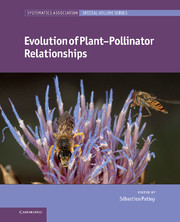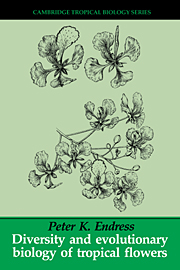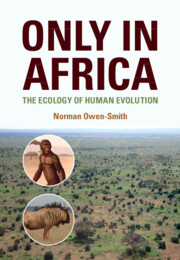Evolution of Plant-Pollinator Relationships
Part of Systematics Association Special Volume Series
- Editor: Sébastien Patiny, Université de Mons-Hainaut, Belgium
- Date Published: December 2011
- availability: Available
- format: Hardback
- isbn: 9780521198929
Hardback
Other available formats:
eBook
Looking for an inspection copy?
This title is not currently available on inspection
-
What are the evolutionary mechanisms and ecological implications behind a pollinator choosing its favourite flower? Sixty-five million years of evolution has created the complex and integrated system which we see today and understanding the interactions involved is key to environmental sustainability. Examining pollination relationships from an evolutionary perspective, this book covers both botanical and zoological aspects. It addresses the puzzling question of co-speciation and co-evolution and the complexity of the relationships between plant and pollinator, the development of which is examined through the fossil record. Additional chapters are dedicated to the evolution of floral displays and signalling, as well as their role in pollination syndromes and the building of pollination networks. Wide-ranging in its coverage, it outlines current knowledge and complex emerging topics, demonstrating how advances in research methods are applied to pollination biology.
Read more- Outlines current knowledge of pollination evolution, including emerging topics, creating a valuable resource for researchers
- Specifically orientated towards the evolution of pollination relationships, covering both botanical and zoological aspects
- Provides an overview of the ecological implications of pollination biology
Customer reviews
Not yet reviewed
Be the first to review
Review was not posted due to profanity
×Product details
- Date Published: December 2011
- format: Hardback
- isbn: 9780521198929
- length: 514 pages
- dimensions: 254 x 203 x 29 mm
- weight: 1.26kg
- contains: 49 b/w illus. 12 colour illus. 32 tables
- availability: Available
Table of Contents
Preface
1. Macroevolution for plant reproductive biologists Paul Wilson
2. Pollination crisis, plant sex systems and predicting evolutionary trends in attractiveness Tom J. de Jong
3. Evolution and ecological implications of 'specialized' pollinator rewards W. Scott Armbruster
4. Fig-fig wasp mutualism, the fall of the strict co-speciation paradigm? Astrid Cruaud, James Cook, Yang Da-Rong, Gwenaëlle Genson, Roula Jabbour-Zahab, Finn Kjellberg, Rodrigo Augusto Santinelo Pereira, Nina Rønsted, Otilene Santos-Mattos, Vincent Savolainen, Rosichon Ubaidillah, Simon van Noort, Peng Yan-Qiong and Jean-Yves Rasplus
5. Fossil bees and their plant associates Denis Michez, Maryse Vanderplanck and Michael S. Engel
6. Pollen evidence for the pollination biology of early flowering plants Shusheng Hu, David L. Dilcher and David Winship Taylor
7. Pollinator mediated floral divergence in the absence of pollinator shifts Allan G. Ellis and Bruce Anderson
8. Animal pollination and speciation in plants: general mechanisms and examples from the orchids Florian P. Schiestl
9. Why are floral signals complex? An outline of functional hypotheses Anne S. Leonard, Anna Dornhaus and Daniel R. Papaj
10. A survey on pollination modes in cacti and a potential key innovation Boris O. Schlumpberger
11. Zygomorphy, area and the latitudinal biodiversity gradient in angiosperms Jana C. Vamosi and Steven M. Vamosi
12. Ambophily and 'super generalism' in Ceratonia siliqua (Fabaceae) pollination Amots Dafni, Talya Marom-Levy, Andreas Jürgens, Stefan Dötterl, Yuval Shimrat, Achik Dorchin, H. Elizabeth Kirkpatrick and Taina Witt
13. Structure and dynamics of pollination networks: the past, the present and the future Jens M. Olesen, Yoko L. Dupont, Melanie Hagen, Claus Rasmussen and Kristian Trøjelsgaard
14. Pollinators as drivers of plant distribution and assemblage into communities Loïc Pellissier, Nadir Alvarez and Antoine Guisan
15. Effects of alien species on plant-pollinator interactions: how can native plants adapt to changing pollination regimes? Gideon Pisanty and Yael Mandelik
16. Pollen resources of non-Apis bees in southern Africa Michael Kuhlmann and Connal D. Eardley
17. Advances in the study of the evolution of plant-pollinator relationships Sébastien Patiny
Index.
Sorry, this resource is locked
Please register or sign in to request access. If you are having problems accessing these resources please email [email protected]
Register Sign in» Proceed
You are now leaving the Cambridge University Press website. Your eBook purchase and download will be completed by our partner www.ebooks.com. Please see the permission section of the www.ebooks.com catalogue page for details of the print & copy limits on our eBooks.
Continue ×Are you sure you want to delete your account?
This cannot be undone.
Thank you for your feedback which will help us improve our service.
If you requested a response, we will make sure to get back to you shortly.
×





